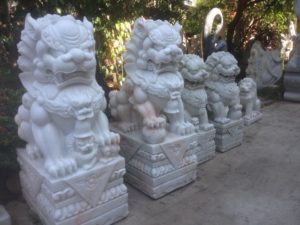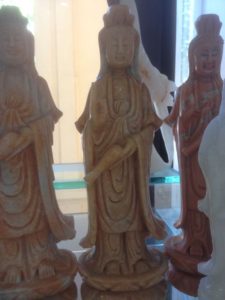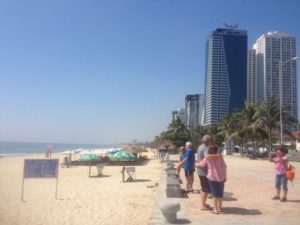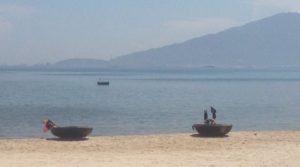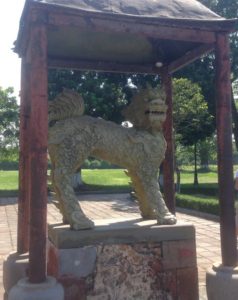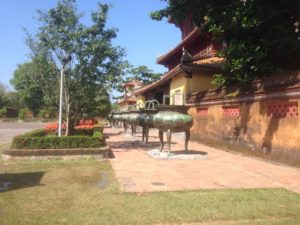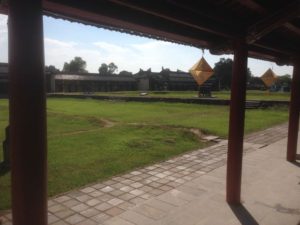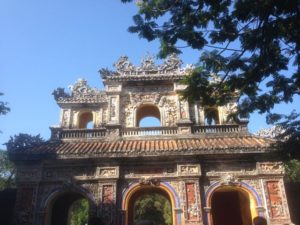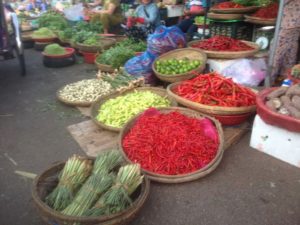On our 4 hour bus ride from Hoi An to Hue, we made several stops, and Tho gave us lots of information about Vietnam’s history, geography, language, religion, and politics.
For 1000 years, Vietnam was ruled by China. In 938, Vietnam became independent but continued to use the Chinese language and feudal system. A Portuguese priest who came from France 300 years ago decided to create an independent language for Vietnam. He combined Chinese and Khmer (Cambodian) sounds with a Latin alphabet of 29 characters to create what is today Vietnamese. There are 6 different tones, so the same word can have 6 different meanings depending on the rising or falling tone (indicated by marks above and below the letters). Vietnamese also has 60 different ways of saying I and you depending on the person’s age and status relation to you.
We stopped at a marble workshop that uses stone from the Marble Mountains. They will ship large objects to the port nearest you, but we limited ourselves to items we could carry.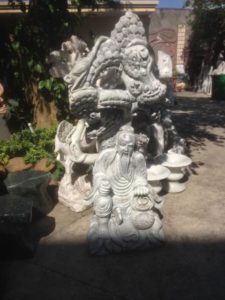
I bought a hand carved female Buddha in peach tones and Steve bought a playful Buddha made from softer stone taken from a stalactite.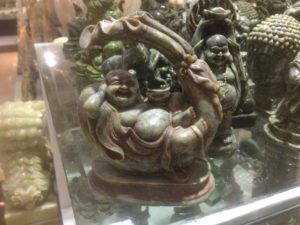
Next, we made a quick picture stop at the original China Beach in Danang, named by GI’s who came for R&R. Every other beach in the south was also named China Beach after this one.
Needless to say, the skyscrapers are a new addition. Apparently, Danang is more open to western development that some other cities.
Next, we stopped to photograph the round bamboo boats that are used to get out past the waves to the fishing boats.
Tho gave us a map of Vietnam with our overnight stays marked in green. The DMZ, established when Ho Chi Minh defeated the French in 1945, is the narrowest part of the country, only 35 mi across. Vietnam is roughly the size of New Mexico but has 2 thousand miles of coastline. Its border with China is 200 miles, with Laos 1300 miles and with Cambodia 800 miles. Three-quarters of the country is mountainous. Luckily, instead of having to wind through the mountains, we were able to use a four-mile long tunnel built with the help of the Japanese and opened in 2005.
We drove past a number of fishing villages with every sort of fish net, fishing huts, and fish farms.
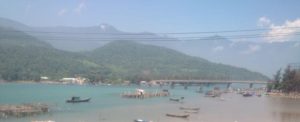 Our next stop (bathroom break) was in a fishing village where we saw fish farms. They were recycling of bike tires to use to hold traps together and to have clams grow on.
Our next stop (bathroom break) was in a fishing village where we saw fish farms. They were recycling of bike tires to use to hold traps together and to have clams grow on.
Tao explained that Vietnamese Buddhism is descended from Mahayana Buddhism from China. There are over 30,000 pagodas (Buddhist places of worship) in Vietnam, but they are smaller than Thai temples. The second religion is Confucianism, and the third is Taoism.
Vietnam comes from Viet (the larges population of people, 65%) and nam, meaning south of China.
He gave us a thumbnail of the history from WWII when Japan occupied the country for several years, and ruled with the Feudal government and French colony. After the war in 1945, Ho Chi Minh declared independence and instituted communism, but the French returned a year later and pushed his forces north into the jungle. They fought for 9 years until 54 when after a truce established the DMZ and elections were supposed to take place in the South, Ho Chi Minh attacked the South and fighting continued until 1975 when the US evacuated.
Vietnam is still communist, with its capital in Hanoi. Every five years, an election is held for representatives who then supposedly elect the General Secretary, President, and Prime Minister. However, these positions are apparently determined well in advance of the election. Corruption is a problem, as it is in Malaysia and Cambodia, with government contracts being awarded based on kick-backs (as much as 30-50% of the cost of a project). Advancement is also based on who one knows.
We checked into our hotel and had an hour for lunch before we left for a tour of the Imperial City, the former Imperial capital built between 1805-1833 by 20,000 workers. 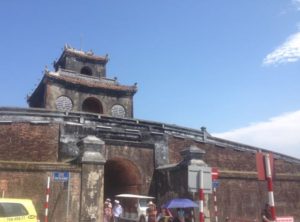 The square structure was modeled on the Forbidden City in Beijing.
The square structure was modeled on the Forbidden City in Beijing.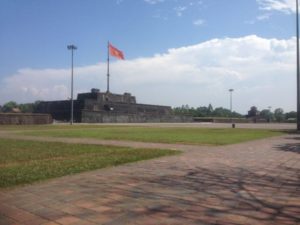 It could hold 100,000 people and each wall is 1.5 miles long.
It could hold 100,000 people and each wall is 1.5 miles long.
There are four main gates and we entered through, you guessed it, Gate 1.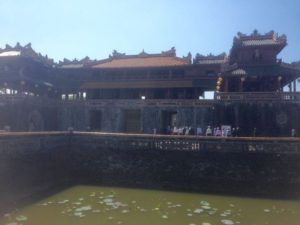
The Nguyen dynasty lasted from 1802 to 1945 when the 13th emperor abdicated. Two days later on September 2, 1945, Ho Chi Minh declared independence.
Koi filled the second moat we crossed.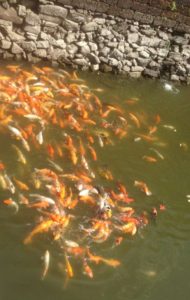
This gate opens onto the inner courtyard. It is decorated in yellow (royalalty), red (happiness and good luck), and purple (immortality).
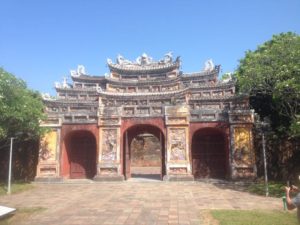 The Palace of Supreme Happiness is the throne room used by all the emperors.
The Palace of Supreme Happiness is the throne room used by all the emperors.  The throne was based on a Ming Dynasty throne. Outside, a unicorn, 1 of 4 holy animals, stands guard.
The throne was based on a Ming Dynasty throne. Outside, a unicorn, 1 of 4 holy animals, stands guard.
The nine brass urns (royal number) that face the Palace symbolize wealth and prosperity.
The Halls of the Mandarins displays photographs of the emperors.
All that is left of the Forbidden Purple City, once the home of the royal family is the red hallways with its ornamental roof.
The interior of the palace was destroyed during the Tet Offensive.
We exited through this lovely gate.
After an hour to freshen up, we left for a one hour Trishaw (Cyclo) tour of the city. It was one of the most intense experiences imaginable. First, we drove through crazy heavy traffic, then over a motor bike and cyclo bridge 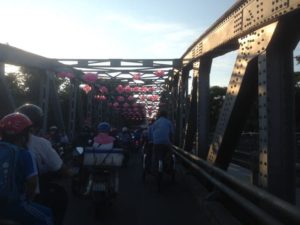 and through the market with its bombardment of sights and sounds.
and through the market with its bombardment of sights and sounds.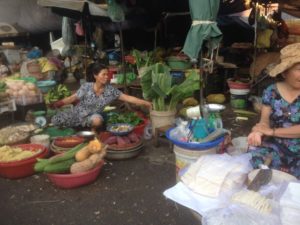
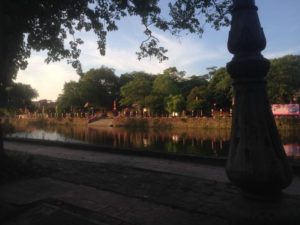 After that, we entered the old city
After that, we entered the old city
and drove through residential neighborhoods. It seemed like most ground floors were open to the street and were a combination of business and living space. It wasn’t unusual to see scooters pulled inside what seemed to be a living room/dining room where kids were playing and people eating.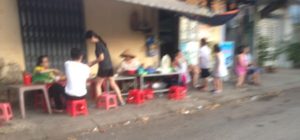 It was impossible to take pictures of all the sights and sounds–girls having their hair done, a modern fitness center, families cooking, eating, and shopping, men sitting out on the street–a thousand sights of everyday life. I noticed that many shop/houses had a light up shrine in the main room.
It was impossible to take pictures of all the sights and sounds–girls having their hair done, a modern fitness center, families cooking, eating, and shopping, men sitting out on the street–a thousand sights of everyday life. I noticed that many shop/houses had a light up shrine in the main room.
Then we arrived at the home of a family that was related to a cook for the emperor (and therefore had the recipes and many of the artifacts) from the past. The altar to pay respects to the ancestors faces the door, 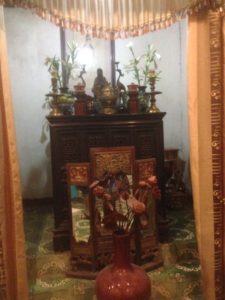 we, and glass cases were filled with china pieces that had been created for the emperor.
we, and glass cases were filled with china pieces that had been created for the emperor.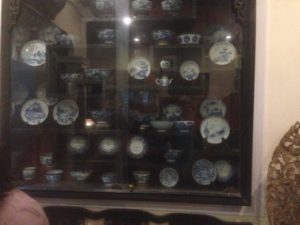 The garden was also lovely.
The garden was also lovely.
 We enjoyed a replica of a few of the over 100 dishes that might have been presented to royal families in the past.
We enjoyed a replica of a few of the over 100 dishes that might have been presented to royal families in the past.
The first dish was spring rolls served on a pineapple with a candle inside decorated to look like a peacock.
Every subsequent dish was presented artfully. The dessert was fresh mango followed by mung bean cake made to look like marzipan fruits.
We felt like emperors.




